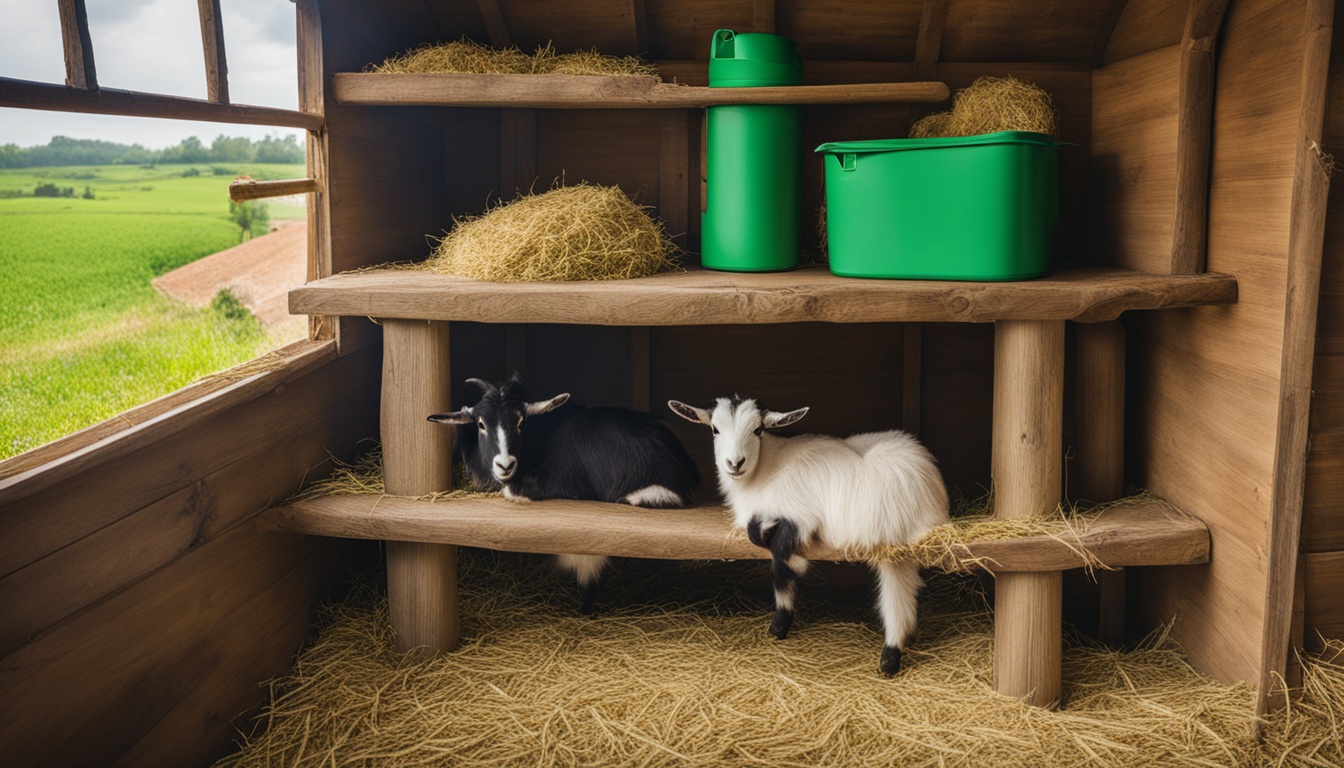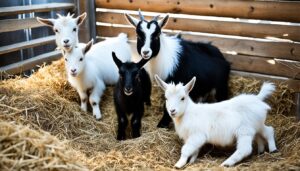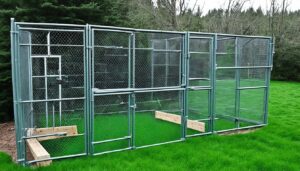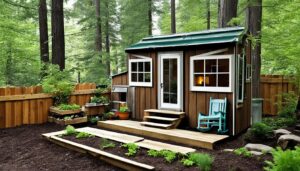Being a goat farmer, I’ve experienced both the joy and difficulties of looking after these lovable animals. Pygmy goats are dear to me because of their fun spirits and kind traits. It’s essential to make their home comfy and practical for their health and my peace of mind. Today, I’ll tell you how to set up a pygmy goat house in a way that makes them happy and keeps you worry-free.
Creating the inside of a pygmy goat house is more than making it look nice – it’s about ensuring it’s safe and enriching for these mini goat friends. We need to think about things like space requirements, wall materials, flooring options, ventilation, and storage for hay and water. This way, your space will be snug and useful for your goat family. I’m here to share important tips and info to help your pygmy goats feel they truly belong.
Key Takeaways
- Proper interior arrangement is crucial for the comfort and well-being of pygmy goats.
- Carefully consider factors like space requirements, wall materials, flooring, ventilation, and storage to create a cozy and functional pygmy goat house.
- Thoughtful planning of the layout and features can provide your herd with a safe, healthy, and enriching living environment.
- Flexibility in the interior arrangement is key to accommodate the changing needs and dynamics of your pygmy goat herd.
- Prioritize the comfort and safety of your pygmy goats to ensure they can thrive in their living space.
Introduction
Proper pygmy goat housing is crucial for their health and happiness. Their shelter should protect them from the weather and let them act naturally. It should also support their social life. Inside a pygmy goat house, the aim is to make a cozy, secure, and fun place for these goats.
Importance of Proper Housing for Pygmy Goats
Having the right goat shelter is key for pygmy goats’ well-being. It has to fit their special needs, so they can live well and be happy.
Goals and Key Considerations
Designing a goat shelter means making a comfy and safe space for pygmy goats. Important things to think about include the size of the indoor space, what the walls and floor are made of, good ventilation, and where to put feeders and bedding. This helps make sure the goats have a great place to live.
Sizing the Indoor Living Space
Creating a comfy and healthy space for pygmy goats indoors is key. You need to consider factors such as the number of goats, their size and age, how they interact, and the climate they’re in. Each of these plays a part in determining the space needed for these small livestock.
Factors Affecting Space Requirements
Experts suggest giving each pygmy goat 20-25 square feet indoors as a start. Yet, this is just the beginning. Paying close attention to your goats is vital. If they look stressed or can’t act normally, they might need more room.
General Space Guidelines
Space needs for pygmy goats indoors can change. But, sticking to general space guidelines for pygmy goats ensures they have enough room. Always keep the happiness and well-being of your goats in mind when planning out their space.

Walls, Doors, and Gates
The walls, doors, and gates in a pygmy goat house are very important. They keep your goats safe and cozy. Choosing the right wall materials makes a big difference. Also, using good insulation is key for warmth and security. Paying attention to door and gate design helps in making sure your goats are safe and don’t get hurt.
Wall Materials and Insulation
When making a pygmy goat house, pick materials that are strong. These materials should last long and keep the goats safe. Wood is a great choice because it provides good insulation. It’s also easier to fix than metal. Good insulation means the house stays warm. This is very important for pygmy goats because they like to be cozy.
Door and Gate Design for Safety
The doors and gates in a pygmy goat house need to be safe. It’s important to use strong materials and locks. This helps keep the goats in and safe from harm. Install sliding doors and strong gates to keep everything secure. By thinking about the door and gate design, you make sure your goats are in a protected space.
Flooring Options
Choosing the right floor for my pygmy goat house required careful thought. I’ve looked at three main options: concrete, wood, and packed earth. Each has its own benefits and downsides.
Pros and Cons of Different Floor Materials
Concrete is tough and lasts a long time, making it a popular pick. Yet, it’s not the best for my pygmy goats’ comfort. Over time, it can be tough on their joints. So, I weighed up the pros and cons before making a final decision.
Wood floors offer a soft surface, which is better for my goats. But keeping them clean is a task. Plus, wood can rot over time. This can lead to more problems down the line.
I settled on packed earth for my goat house’s floor. It’s soft, provides good grip, and suits my goats’ nature well. Even though upkeep is more, the benefits in terms of comfort and safety for my goats are worth it.

Ventilation and Climate Control
Having the right ventilation in a pygmy goat house is key. It keeps the air fresh and stops ammonia and moisture from building up. Make sure the shelter can let air flow through from different directions. Adding small windows or openings for air is smart. Beware of blocking the air completely, as it could harm your goats’ breathing.
Climate is crucial too. Your pygmy goat shelter needs to stay not too hot or too cold. You might need more insulation, heaters, or fans. This way, you’ll keep your goats happy and healthy all year.

Bedding Choices
Choosing the right bedding for your pygmy goat house is crucial. I, as a pygmy goat owner, have tested several materials. Each has its pros and cons. Let’s look at some favored choices for these cute pets.
Straw vs. Wood Shavings
Straw is a traditional, cost-effective bedding choice. It’s cozy and offers decent insulation. But, it can smell and becomes less absorbent over time. This means you’ll need to clean more often.
Wood shavings, by contrast, are very absorbent. They help the goat house stay cleaner but require more frequent topping up for comfort.
Absorbent Hemp and Flax Bedding
Hemp-based bedding, like Aubiose, and flax are top-notch for pygmy goats. They’re super absorbent. This makes them great at controlling smells and keeping the area dry. They also improve air quality, essential for your goat’s health.
Remember, the bedding should be 4-5 inches deep for enough warmth and softness.

Hay Feeders and Water Troughs
In a well-designed home, pygmy goats need good eating and drinking places. Using the right pygmy goat hay feeder design is key. It can help stop kids from getting hurt. Hay feeders with covers keep young goats out, making things safer. They also need to be the right height for all goats to use easily.
Hay Feeder Designs to Prevent Injuries
When picking hay feeders for pygmy goats, safety is crucial. Choose those that prevent injuries, like ones with covers. This stops goats from climbing in and keeps things tidy. Feeder designs that adjust to different goat heights ensure everyone can eat comfortably.
Watering Options for Kids and Adults
For pygmy goats, having enough clean water is very important. Use water troughs for pygmy goats that prevent spills. Also, add separate, lower water bowls for the kids. This way, every goat can drink easily.
Keep all water and feeding equipment for pygmy goats strong and clean. This helps keep the goats healthy by stopping germs from spreading.

How should I arrange the interior of a pygmy goat house?
When setting up a pygmy goat house, it’s crucial to be flexible. This lets you change things as your goat herd grows and changes. Using hurdles that can move helps make different areas as needed. You might use these pens for newborns, to separate goats that don’t get along, or just to give one goat its own space.
Flexible Pen Layouts Using Hurdles
Flexible pen layouts using hurdles are helpful in a pygmy goat house. They let you meet your herd’s specific needs. With barriers that can be moved, you can make and change areas in the shelter. This helps keep new kids safe, fix social problems, or add more space for a single goat.
Permanent Partitions and Extra Pens
Not just hurdles, but also having permanent partitions and extra pens can be very useful. Especially if your pygmy goat group is big or diverse. These fixed structures keep the place organized. They allow the space to be adjusted as your herd changes over time.
It’s key to think about how goats will move around inside. Also, how they can get to their food and water easily. Using both flexible and fixed things in the shelter makes a comfortable home for your goats. It meets their unique needs as they grow and change.

Outdoor Space and Fencing
Pygmy goats need a safe area outside for fun and exercise. This spot should be dry so goats don’t slip. The outside should have a dry space around their shelter. This helps their feet stay healthy. The fence around should be high and strong to keep goats in without danger.
Fencing Types and Safety Considerations
Use strong wire or electric fencing for safety. You can also add a top rail to stop goats from jumping out. Think about your fencing carefully. It will make sure your pygmy goats stay safe while they play outside. Each goat needs at least 130 sq ft, but some owners give more.
Think about the weather and what your goats eat. The size of your group matters, too. If you have a buck, they might need their own space. You should make sure each goat has enough room inside and outside. This keeps them happy and healthy.

Conclusion
For pygmy goats, a cozy and well-organized living space is key. It’s vital for their health, happiness, and overall well-being. By setting up their shelter wisely, you ensure they have a snug and practical home.
Many things matter, from the right size and layout to the materials used. Everything affects how well your pygmy goats do.
Setting it up right means they have a secure and fun place to live. It should match their natural needs and ways of living. By focusing on their comfort and safety, your goats will be healthy and happy.
As you design your goat’s home, check out tips on good fencing. This is crucial for keeping them safe and sound.
Keep an eye on your goats and tweak things as you go. By watching and adjusting, you make sure they have a great home. And that leads to happy, thriving goats in your care.
FAQ
What factors affect the size requirements for a pygmy goat house?
The number of goats, their size, and age affect indoor living space needs. Group dynamics and climate play a role too. Experts advise at least 20-25 square feet per goat. But, you might need more space for your herd’s specific needs.
What type of wall materials are best for a pygmy goat house?
Choose wood over metal for the best pygmy goat house walls. Wood provides better insulation and is easier to fix. Make sure the house stays comfy all year. For safety, use strong materials and secure latches for doors and gates.
What is the ideal flooring option for a pygmy goat house?
A dirt or packed earth floor is best for pygmy goats. It offers a natural cushion and good traction. Long term, concrete floors can hurt the goats’ joints. And wood can get dirty and rot.
How can I ensure proper ventilation in a pygmy goat house?
Good ventilation is key to a healthy pygmy goat house. This keeps the air fresh and the place dry. Cross-ventilation is great, with adjustable windows or openings. Never seal the structure completely; bad ventilation can cause health problems.
What type of bedding is best for a pygmy goat house?
Go for hemp-based or flax bedding to keep your pygmy goats’ house healthy. These beddings prevent breathing problems. Aim for a layer that’s 4-5 inches deep. This keeps your goats warm and provides a soft place to sleep.
How should I arrange the feeding and watering stations in a pygmy goat house?
Ensure safety by using hay feeders with lids to keep kids out. The feeder’s height should suit both adult goats and kids. Put water troughs off the ground to avoid spills. Include smaller bowls for the kids. This makes feeding time easier and tidier.
How can I create a flexible layout for a pygmy goat house?
Use movable hurdles for quick pen creation. For permanent needs, partitions and extra pens work well. Think about how your goats move, access their needs, and where you can check on them easily. This helps you plan a functional and versatile layout.
What are the key considerations for the outdoor space in a pygmy goat house?
A firm space around the shelter helps avoid mud and keeps things dry. Choose strong, well-maintained fencing to keep your goats in and hazards out. Woven wire or electric fences with a top rail are a good option. This helps prevent escapes by jumping.



